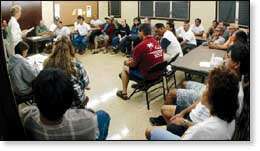KAUMAKANI-A meeting at Kaumakani Recreation Center Thursday evening drew a much larger crowd than expected of Kauai residents who are up in arms about the U.S. Fish and Wildlife Service’s planned critical habitats. Just over 10 people showed up to
KAUMAKANI-A meeting at Kaumakani Recreation Center Thursday evening drew a much larger crowd than expected of Kauai residents who are up in arms about the U.S. Fish and Wildlife Service’s planned critical habitats.
Just over 10 people showed up to the first meeting at Hanapepe Neighborhood Center last week, when the Concerned Citizens of Kauai and Niihau got the ball rolling with a petition and discussion opposing the critical habitat proposal.
Over 2,500 people signed the petition by Thursday, said Betty Chandler, chairwoman pro tem. The group wants elected government officials to ensure that less land area is included in the final draft of the critical habitat; guarantee public access to lands; and protect the rights of private landowners.
Many of the 40 to 50 people who attended Thursday’s meeting were hunters and recreational land users who wanted to get more information about the proposed critical habitat designations for plants, and what the designation would mean to them.
“It is our challenge to say whether we want this on our island or not. We’re allowing the government to be the bully on us,” Jimmy Torio, host of the KQNG radio program “Island Talk,” said at the meeting.
In 1998, The Fish and Wildlife Service was ordered by Hawaii District Court to publish proposed designations of critical habitats for endangered species in Hawai’i, after a successful lawsuit by the environmental law group Earthjustice.
“Hawaii’s environmental movement has become corrupt,” said Keith Robinson, operator of the Kauai Wildlife Reserve. Robinson claimed “money and power” are the motives that usually drive the environmental groups who sue the federal government, not truly caring for the land.
The only time environmental groups do field work is if they can somehow make a profit, Robinson said, adding that they are too lazy and incompetent to do the kind of work he’s done in raising and protecting endangered plants over the past 15-20 years.
The U.S. Fish and Wildlife Service has added tens of thousands of acres to their original critical habitat proposal, bringing the total to 99,000 acres — and leading opponents to believe they are trying to avoid further court scrutiny. The Fish and Wildlife Service states the goal is for these plants to naturally recover in their native habitats so they can be removed from the list of endangered and threatened species.
Robinson said during his years of working with native plants, he’s discovered they are biologically incompetent and can’t compete against introduced species in the wild. Without funding and manpower to maintain the plants, there’s no way the plants can survive on their own, said Robinson.
Hunters, the largest group of critical habitat opponents, are worried they won’t be able to go hunting on critical habitat lands should the Fish and Wildlife Service get all the acreage in their revised proposal. Misinformation and confusion over what will happen to hunters’ access rights seemed to lead to resentment of the proposal.
Dealing with the Fish and Wildlife Service is an exercise in futility, said Elton Ushio, president of the Kauai Hunting Association. Talks with Paul Henson, field supervisor of the Fish and Wildlife Service’s Pacific Islands Ecoregion, have left the Kauai Hunting Association at a standstill.
“They have not incorporated any of our suggestions and they’re not listening to the Kaua’i community,” Ushio said.
The Concerned Citizens of Kauai and Niihau have volunteers who will serve on an organizational committee. They presented Patsy Mink with copies of the petition Friday at County Council chambers, and will wait for her to act before scheduling another public meeting.


